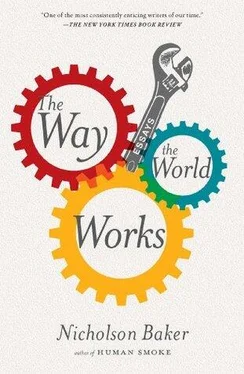Nicholson Baker - The Way the World Works
Здесь есть возможность читать онлайн «Nicholson Baker - The Way the World Works» весь текст электронной книги совершенно бесплатно (целиком полную версию без сокращений). В некоторых случаях можно слушать аудио, скачать через торрент в формате fb2 и присутствует краткое содержание. Год выпуска: 2012, Издательство: Simon & Schuster, Жанр: Публицистика, Критика, на английском языке. Описание произведения, (предисловие) а так же отзывы посетителей доступны на портале библиотеки ЛибКат.
- Название:The Way the World Works
- Автор:
- Издательство:Simon & Schuster
- Жанр:
- Год:2012
- ISBN:нет данных
- Рейтинг книги:4 / 5. Голосов: 1
-
Избранное:Добавить в избранное
- Отзывы:
-
Ваша оценка:
- 80
- 1
- 2
- 3
- 4
- 5
The Way the World Works: краткое содержание, описание и аннотация
Предлагаем к чтению аннотацию, описание, краткое содержание или предисловие (зависит от того, что написал сам автор книги «The Way the World Works»). Если вы не нашли необходимую информацию о книге — напишите в комментариях, мы постараемся отыскать её.
), here assembles his best short pieces from the last fifteen years.
The Way the World Works
OED
Modern Warfare 2
Through all these pieces, many written for
, and
, Baker shines the light of an inexpugnable curiosity.
is a keen-minded, generous-spirited compendium by a modern American master.
The Way the World Works — читать онлайн бесплатно полную книгу (весь текст) целиком
Ниже представлен текст книги, разбитый по страницам. Система сохранения места последней прочитанной страницы, позволяет с удобством читать онлайн бесплатно книгу «The Way the World Works», без необходимости каждый раз заново искать на чём Вы остановились. Поставьте закладку, и сможете в любой момент перейти на страницу, на которой закончили чтение.
Интервал:
Закладка:
So the reproductions that you see in this book — the art by Bush, J. Campbell Cory, Richard Felton Outcault, Charles Saalburg, George McManus, Marius de Zayas, Dan Smith, and Louis Biedermann; the writing by Mark Twain, Robert Peary, and others — come from what is one of the very last, perhaps the last, set of original copies of the turn-of-the-century New York World in existence — certainly the last in such pristine condition. The set came from England: lucky for us, the British Library, in 1898, as the Spanish-American War loomed, felt that Pulitzer’s World was an essential source of opinion and reportage, and librarians there began subscribing to the World and (just as important) began binding it into durable, red-spined, gold-lettered volumes. For decades, foresightedly, through various financial upheavals and geopolitical reshufflements, they kept these volumes safe on shelves. Then, in 1999, feeling the pinch after opening an expensive new building, the library’s managers made quiet plans to offer much of its foreign (i.e., North and South American and Continental European) newspaper collection to other libraries, and to auction off the unwanted residue to dealers. I was in the midst of writing a book about the particulars of the losses attributable to microfilm — the crudity of the microcopying itself, the perishability of early acetate film, the bogus science predicting acidic paper’s imminent doom — when I learned of the British Library’s disposal plans. So I went to England and asked them to keep the American papers. I said that they were rich and rare — which they certainly are — and that I knew that they held, for example, true “first editions” of the writings of Stephen Crane, O. Henry, Robert Benchley, John Steinbeck, H. G. Wells, Thomas Edison, William Faulkner, and hundreds of other writers, some named, some anonymous. I said that their foreign newspaper collection was just as valuable as, and considerably rarer than, just about any acknowledged rarity in their possession — rarer, for example, than the justly treasured output of Renaissance printers such as Aldus, Plantin, and Wynkyn de Worde. A century ago, newspapers like the World, the Chicago Tribune, the New-York Tribune, and many others were everywhere and were read by everyone; now they are almost nowhere: their historico-artifactual resplendence and indispensability was, it seemed to me, beyond dispute. Not only that — so I argued — but if we ever wanted to make better reproductions of the newspapers than microfilming offered — if we wanted to make digital or even old-fashioned analog reproductions in color, for instance — we would need the original pages to work from: you can’t make a sharp, continuous-tone color photograph out of a fuzzy, high-contrast black-and-white microcopy. So I said to the librarians in England.
But my anti-sales pitch wasn’t successful — the British librarians had gotten some interesting faxed-in bids from a Pennsylvanian dealer by the time I visited, and, it seemed, they simply wanted his money. And I knew what that meant. It meant box-cutter butchery and plastic-sheathed, issue-by-issue dispersal, and I concluded that the only way to save the collection was to raise the money to buy it and ship it to leased quarters in the United States. So my wife and I — my wife being Margaret Brentano, the editor and caption writer of this book — formed a nonprofit organization, grandiosely named the American Newspaper Repository, though it was really just the two of us overseen by some kindly advisers, and we bought more than six thousand volumes of American newspapers (a volume being anywhere from two weeks’ to three months’ worth of daily issues), plus another thousand wrapped bundles, most in extraordinarily good condition, all formerly owned by the British government. The cost, including two long runs that we ended up buying from a dealer who had outbid us, was approximately $150,000; the collection arrived in several shipments in 2000.
And that’s how we came to be standing at tables in a large chilly brick mill building in Rollinsford, New Hampshire, paging with wonderment through Pulitzer’s almost-lost World . The mill space we had rented, for two thousand dollars a month, was the size of two, maybe three, tennis courts, with rows of battered, factory-blue metal columns running down it and an inflatable black bat strung near a fire door at the far end. In Pulitzer’s day, and well before, the building had held enormous, noisy, oil-dripping looms (which looked somewhat like newspaper printing presses), but when we got there the place had become extremely quiet. Over near the loading dock, the Humpty Dumpty Potato Chip Company stored boxes of barbecue-flavored snacks in metal cages; above us was the ever-shrinking presence of Damart, the French maker of silk underwear, latterly brought low by Asian competition. One of the mill’s upper floors was jammed with cast-off hospital equipment — evil-looking gurneys and examination tables, failed heart monitors, vintage monster-movie X-ray machines — all trucked there by a man of mystery and energy who purportedly assembled medical clinics in third-world countries.
A former Damart employee volunteered to build a wall for us and install lights: suddenly we found that we had a huge still expanse with a sign on the door that said AMERICAN NEWSPAPER REPOSITORY. I put up a few dozen extra-long window shades, because newsprint is better off in the dark, but the late-afternoon sun slipped in along the edges of the window frames and striped the floor with long, dusty blades that crumpled over the backs of volunteers — students, teachers, librarians, my own children — as they unloaded pallet after pallet of newspaper volumes and sorted them into yearly piles by title and date. (The British Library had shipped them to us in semi-random order.) We bought ten-foot-high industrial shelving till we ran out of money. Our shelved run of the New York Times was impressive; like a steam locomotive and its tender, it ran down much of the length of the room. Occasionally, students of history or journalism would come and browse through issues, taking notes, sitting on old hospital chairs, or some scholar would visit in search of a specific article or image or theme.
And the World ? We loved its heavy, vellum-cornered volumes, which smelled faintly of acid paper: 1898 began on the upper left of the shelving, at the very top; one range over, there were the fat monthly tomes from 1903 and 1906 (for some reason I became particularly fond of the year 1906), and then the teens, and then on the other side of the shelves (near windows that, if you peeked under the shades, looked down on the Salmon Falls River), the run ran on through the World ’s more sophisticated, literary period, when it invented the crossword puzzle, published Dorothy Parker and A. J. Liebling, and exposed the misdeeds of the Ku Klux Klan. Over several months, Margaret went through every World volume from 1898 to 1911, the year of Pulitzer’s death. “Take a look at this airship!” she called. “You’ve got to see this Biedermann!” She found scenic wonders and oddities everywhere, marking them with strips of paper, but especially in the Sunday issues, where the World ’s editors and illustrators and writers were obviously having a fantastic time — cackling to themselves, we imagined, as every week they published another vaudeville revue of urban urges and preoccupations. The world should know about the World, we felt. Why should an artist such as Dan McCarthy, who gave us “The American Sky-Scraper Is a Modern Tower of Babel,” be totally forgotten? You can go to a museum to see the paintings of Ashcan School artist George Luks, but his disturbing newspaper drawings of 1898, “The Persecution Mania” and “All Is Lost Save Honor,” exist only on microfilm, as far as I can tell, apart from these pages. The World ’s innovations in page design, in color “electrogravure” printing, in puzzles and children’s illustration, in teasingly elaborate charts, and in swervy, swoopy typography are everywhere evident to a modern eye; perhaps it’s time to take a preliminary step toward restoring the Sunday paper to its rightful place in the history of American vernacular art.
Читать дальшеИнтервал:
Закладка:
Похожие книги на «The Way the World Works»
Представляем Вашему вниманию похожие книги на «The Way the World Works» списком для выбора. Мы отобрали схожую по названию и смыслу литературу в надежде предоставить читателям больше вариантов отыскать новые, интересные, ещё непрочитанные произведения.
Обсуждение, отзывы о книге «The Way the World Works» и просто собственные мнения читателей. Оставьте ваши комментарии, напишите, что Вы думаете о произведении, его смысле или главных героях. Укажите что конкретно понравилось, а что нет, и почему Вы так считаете.












